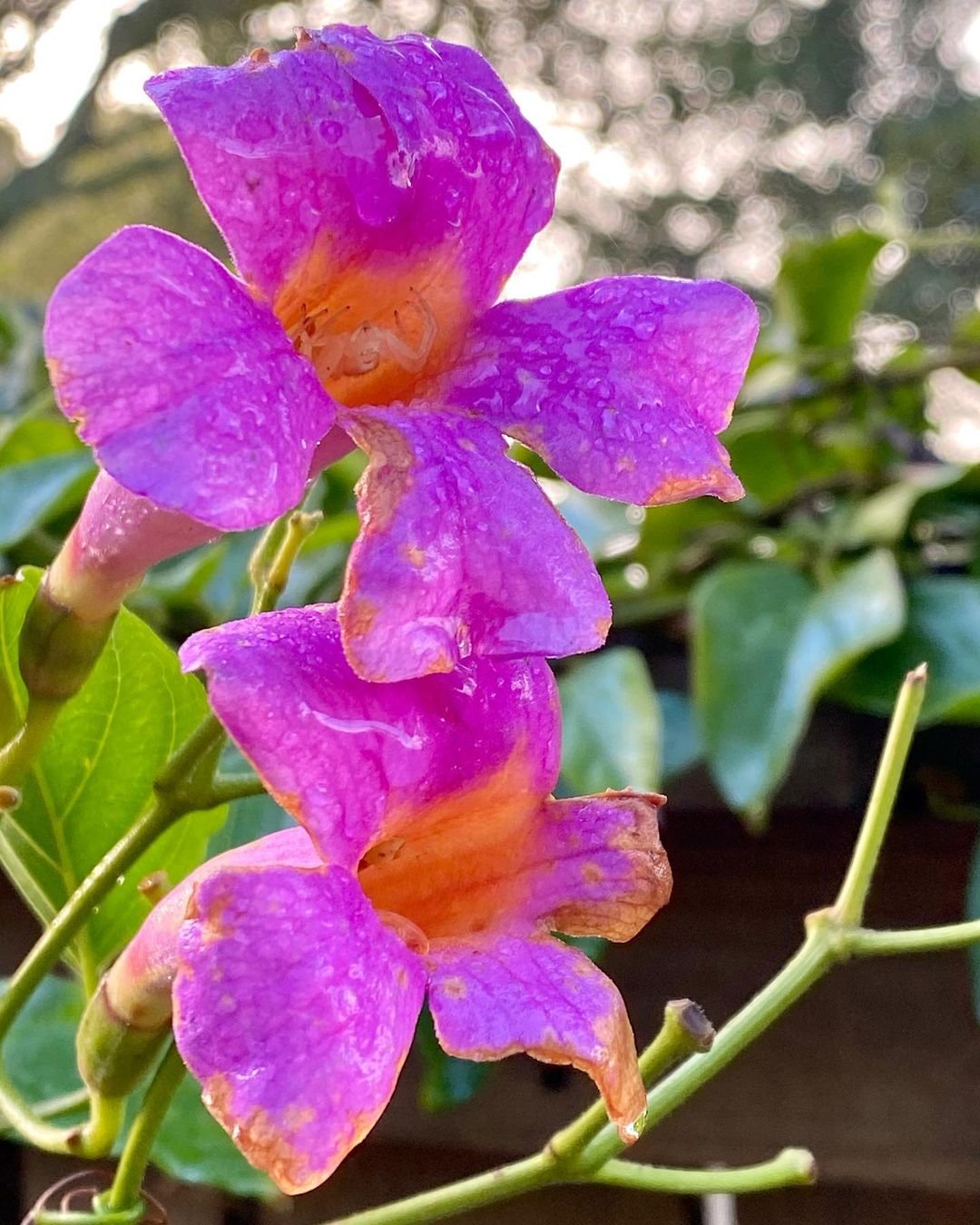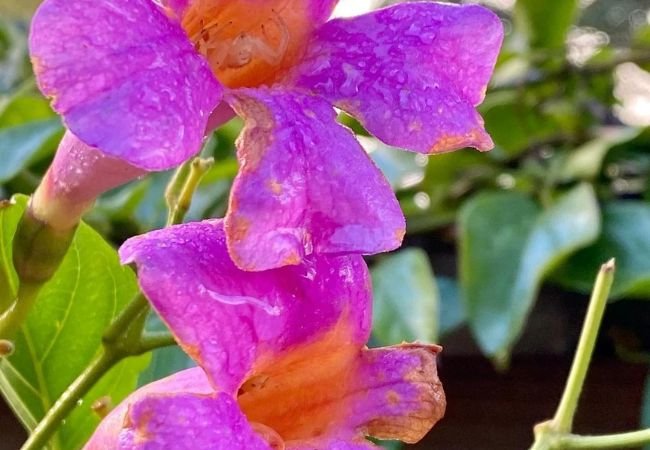Discover how to grow and care for purple honeysuckle, a unique and eye-catching climbing plant. Learn tips for planting, maintenance and adding this vibrant bloom to your garden.
Purple honeysuckle is a stunning and fragrant climbing plant that can add a touch of elegance to any garden. With its vibrant purple blooms and sweet scent, it’s a favorite among gardeners and pollinators alike. In this guide, we’ll explore everything you need to know about growing and caring for purple honeysuckle.
Here’s a detailed chart for the Purple Honeysuckle, focusing on a common variety, Lonicera caerulea:
| Category | Information |
|---|---|
| Botanical Name | Lonicera caerulea |
| Common Name | Purple Honeysuckle, Honeyberry |
| Plant Type | Deciduous Shrub or Vine |
| Hardiness Zone | 2-8 |
| Sun Exposure | Full Sun to Partial Shade |
| Soil Type | Well-drained, Moist, Fertile Soil |
| Watering | Moderate, Keep Soil Moist |
| Growth Habit | Upright, Climbing (if Trellised) |
| Height/Spread | 4-6 feet tall / 4-6 feet wide |
| Flowering Time | Late Spring to Early Summer |
| Flower Description | Tubular, Fragrant Flowers in Shades of Purple or Lavender |
| Fruit | Edible Blue Berries, Typically Ripen in Summer |
| Special Features | Attracts Pollinators (Bees, Hummingbirds), Edible Fruit, Tolerant of Cold Winters, Low Maintenance |
What is Purple Honeysuckle?

Purple honeysuckle (Lonicera japonica ‘Purpurea’) is a variety of the Japanese honeysuckle. It’s known for its:
- Purple-tinged foliage
- Fragrant, tubular flowers that start white and turn yellow
- Vigorous climbing habit
- Ability to attract hummingbirds and butterflies
While many honeysuckle varieties have yellow or pink flowers, the purple honeysuckle stands out with its unique coloration.
Benefits of Growing Purple Honeysuckle
There are several reasons to consider adding purple honeysuckle to your garden:
- Visual appeal: The purple-tinged leaves and colorful flowers add interest to fences, walls, or trellises.
- Fragrance: The sweet scent can perfume your entire garden.
- Wildlife attraction: It’s a favorite of hummingbirds, butterflies and bees.
- Low maintenance: Once established, it requires minimal care.
- Fast growth: It can quickly cover structures or act as a privacy screen.
How to Grow Purple Honeysuckle
Follow these steps to successfully grow purple honeysuckle in your garden:
Choosing the Right Location
Purple honeysuckle thrives in:
- Full sun to partial shade
- Well-draining soil
- Areas with good air circulation
Ideal locations include:
- Along fences or walls
- On trellises or arbors
- As a ground cover in large areas
Planting Purple Honeysuckle
The best time to plant is in spring or fall. Here’s how:
- Dig a hole twice the size of the root ball.
- Mix compost into the soil to improve drainage and nutrition.
- Place the plant in the hole at the same depth it was in its container.
- Backfill with soil and water thoroughly.
- Mulch around the base to retain moisture and suppress weeds.
Providing Support
As a climbing plant, purple honeysuckle needs support to grow vertically:
- Install a trellis, fence, or other structure before planting.
- Guide young vines onto the support structure.
- Use soft ties to secure the vines if needed.
Caring for Purple Honeysuckle
Once established, purple honeysuckle is relatively low-maintenance. Here’s how to keep it healthy:
Watering
- Water deeply once a week during the growing season.
- Increase watering during dry spells.
- Avoid overhead watering to prevent fungal diseases.
Fertilizing
- Apply a balanced, slow-release fertilizer in early spring.
- Avoid over-fertilizing, which can lead to excessive growth.
Pruning
Proper pruning is essential for maintaining the shape and health of your purple honeysuckle:
- Prune in late winter or early spring before new growth begins.
- Remove dead, damaged, or diseased wood.
- Thin out crowded areas to improve air circulation.
- Cut back overly long or straggly vines to maintain shape.
Pest and Disease Management
While generally hardy, purple honeysuckle can sometimes face issues:
- Aphids: Spray with water or use insecticidal soap.
- Powdery mildew: Improve air circulation and avoid overhead watering.
- Leaf blight: Remove affected leaves and improve air circulation.
Companion Plants for Purple Honeysuckle
Enhance your garden by pairing purple honeysuckle with complementary plants:
- Clematis: Another climbing plant with different bloom times.
- Roses: Combine for a classic cottage garden look.
- Lavender: Adds contrasting color and fragrance.
- Ornamental grasses: Provide texture contrast.
Using Purple Honeysuckle in Your Landscape
Purple honeysuckle is versatile in the garden. Consider these ideas:
- Cover a pergola or arbor for a fragrant seating area.
- Train along a fence for a living privacy screen.
- Use as a ground cover on slopes for erosion control.
- Grow in hanging baskets for a cascading effect.
Common Questions About Purple Honeysuckle
Is purple honeysuckle invasive?
While some honeysuckle species can be invasive, purple honeysuckle is generally less aggressive. However, it’s always a good idea to check with local gardening authorities about potential invasiveness in your area.
How fast does purple honeysuckle grow?
Purple honeysuckle is a fast grower, potentially adding 10-20 feet of growth in a season under ideal conditions.
Can purple honeysuckle be grown in containers?
Yes, but choose a large container with good drainage. Be prepared to provide strong support and regular pruning to manage its size.
Is purple honeysuckle toxic to pets?
Some parts of the plant can be toxic if ingested in large quantities. It’s best to keep pets from eating the berries or leaves.
Purple honeysuckle is a beautiful and rewarding plant to grow in your garden. With its unique purple-tinged foliage and fragrant blooms, it can add a touch of elegance and charm to any outdoor space. By following the planting and care tips outlined in this guide, you can enjoy the beauty of purple honeysuckle for years to come.
Remember to provide adequate support, regular watering, and proper pruning to keep your purple honeysuckle healthy and vibrant. Whether you’re using it to cover a fence, create a fragrant seating area, or attract wildlife to your garden, purple honeysuckle is sure to be a standout feature in your landscape.
Happy gardening, and enjoy the sweet fragrance and beauty of your purple honeysuckle!








Leave a Reply